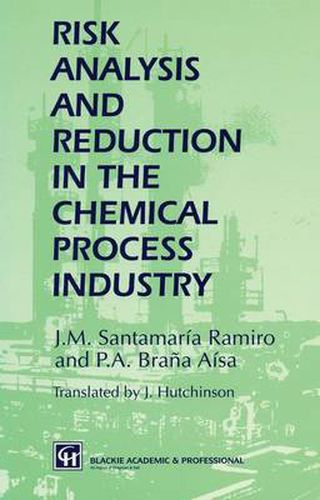Readings Newsletter
Become a Readings Member to make your shopping experience even easier.
Sign in or sign up for free!
You’re not far away from qualifying for FREE standard shipping within Australia
You’ve qualified for FREE standard shipping within Australia
The cart is loading…






This title is printed to order. This book may have been self-published. If so, we cannot guarantee the quality of the content. In the main most books will have gone through the editing process however some may not. We therefore suggest that you be aware of this before ordering this book. If in doubt check either the author or publisher’s details as we are unable to accept any returns unless they are faulty. Please contact us if you have any questions.
Concern for the environment has become one of the big issues in modern society, and one of the chief concerns is the environmental impact of modern industrial production. A particularly sensitive issue is the possibility of accidents in industries where there may be severe consequences for people, property and the environment. At one time the nuclear industry was seen as the most likely to be the cause of significant environmental damage, but after the occurrence of several major accidents such as Seveso, Flixborough and Bhopal, that concern extends to much of the chemicals industry. Pressure from society, reflected by strong legislation, coupled with a greater understanding of the impact chemical processing operations can have, has lead to the adoption of higher profile safety and environmental management programmes within the chemical industry. Under these programmes existing and new processes are rigorously examined to determine the possible causes and consequences of failure, and the results used to improve the process to make failure less likely. Any process audit, aimed at improving safety or lessening the environmental impact, cannot be carried out using intuition or experience alone, so the discipline of risk analysis has grown as a collection of tools and methods which can be utilized to give a quantitive assessment of the risks involved in operating any given process. This monograph examines risk analysis and reduction, emphasizing the various different methods which can be used together, in a global approach, to risk analysis in the chemical process industries. It should be of interest to those involved in risk assessment, environmental impact assessment or safety planning.
$9.00 standard shipping within Australia
FREE standard shipping within Australia for orders over $100.00
Express & International shipping calculated at checkout
This title is printed to order. This book may have been self-published. If so, we cannot guarantee the quality of the content. In the main most books will have gone through the editing process however some may not. We therefore suggest that you be aware of this before ordering this book. If in doubt check either the author or publisher’s details as we are unable to accept any returns unless they are faulty. Please contact us if you have any questions.
Concern for the environment has become one of the big issues in modern society, and one of the chief concerns is the environmental impact of modern industrial production. A particularly sensitive issue is the possibility of accidents in industries where there may be severe consequences for people, property and the environment. At one time the nuclear industry was seen as the most likely to be the cause of significant environmental damage, but after the occurrence of several major accidents such as Seveso, Flixborough and Bhopal, that concern extends to much of the chemicals industry. Pressure from society, reflected by strong legislation, coupled with a greater understanding of the impact chemical processing operations can have, has lead to the adoption of higher profile safety and environmental management programmes within the chemical industry. Under these programmes existing and new processes are rigorously examined to determine the possible causes and consequences of failure, and the results used to improve the process to make failure less likely. Any process audit, aimed at improving safety or lessening the environmental impact, cannot be carried out using intuition or experience alone, so the discipline of risk analysis has grown as a collection of tools and methods which can be utilized to give a quantitive assessment of the risks involved in operating any given process. This monograph examines risk analysis and reduction, emphasizing the various different methods which can be used together, in a global approach, to risk analysis in the chemical process industries. It should be of interest to those involved in risk assessment, environmental impact assessment or safety planning.